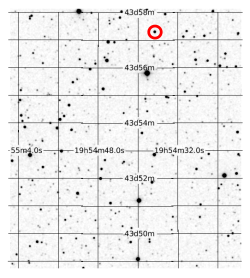| Observation data Epoch J2000.0 Equinox J2000.0 | |
|---|---|
| Constellation | Cygnus |
| Right ascension | 19h 54m 36.6535s[2] |
| Declination | +43° 57′ 18.026″[2] |
| Apparent magnitude (V) | 15.29[3] |
| Characteristics | |
| Evolutionary stage | Main sequence |
| Spectral type | M1V[4] |
| Astrometry | |
| Proper motion (μ) | RA: 2.171(18) mas/yr[2] Dec.: −4.363(20) mas/yr[2] |
| Parallax (π) | 5.6336 ± 0.0169 mas[2] |
| Distance | 579 ± 2 ly (177.5 ± 0.5 pc) |
| Absolute magnitude (MV) | 6.3 |
| Details | |
| Mass | 0.544 ± 0.02[4] M☉ |
| Radius | 0.523 ± 0.02[4] R☉ |
| Luminosity (bolometric) | 0.055 +0.011 −0.006[4] L☉ |
| Temperature | 3755 ± 90[4] K |
| Metallicity [Fe/H] | −0.26 ± 0.12[4] dex |
| Rotation | 34.404±0.075 days[5] |
| Age | 4.0 ± 0.6[4] Gyr |
| Other designations | |
| Database references | |
| SIMBAD | data |
Kepler-186 is a main-sequence M1-type dwarf star, located 177.5 parsecs (579 light years) away in the constellation of Cygnus. The star is slightly cooler than the sun, with roughly half its metallicity. It is known to have five planets, including the first Earth-sized world discovered in the habitable zone: Kepler-186f.[6] The star hosts four other planets discovered so far, though they all orbit interior to the habitable zone.
- ^ SIMBAD, KIC8120608
- ^ a b c d Cite error: The named reference
Gaia DR3was invoked but never defined (see the help page). - ^ Cite error: The named reference
Souto2017was invoked but never defined (see the help page). - ^ a b c d e f g "Kepler-186 f". NASA Exoplanet Archive. Retrieved 19 July 2016.
- ^ Cite error: The named reference
McQuillan2013was invoked but never defined (see the help page). - ^ Quintana, E. V.; Barclay, T.; Raymond, S. N.; Rowe, J. F.; Bolmont, E.; Caldwell, D. A.; Howell, S. B.; Kane, S. R.; Huber, D.; Crepp, J. R.; Lissauer, J. J.; Ciardi, D. R.; Coughlin, J. L.; Everett, M. E.; Henze, C. E.; Horch, E.; Isaacson, H.; Ford, E. B.; Adams, F. C.; Still, M.; Hunter, R. C.; Quarles, B.; Selsis, F. (2014-04-18). "An Earth-Sized Planet in the Habitable Zone of a Cool Star". Science. 344 (6181): 277–280. arXiv:1404.5667. Bibcode:2014Sci...344..277Q. doi:10.1126/science.1249403. PMID 24744370. S2CID 1892595. free version = http://www.nasa.gov/sites/default/files/files/kepler186_main_final.pdf
